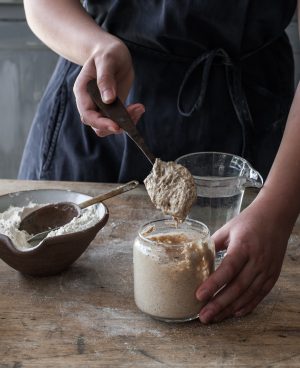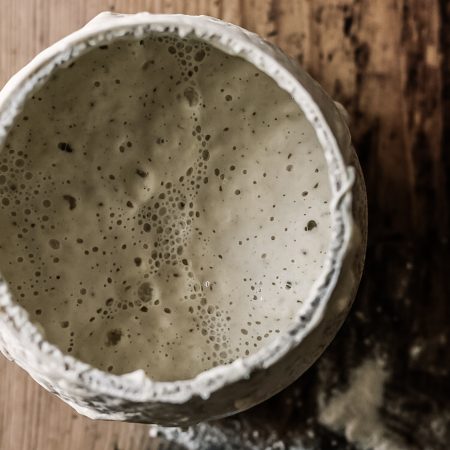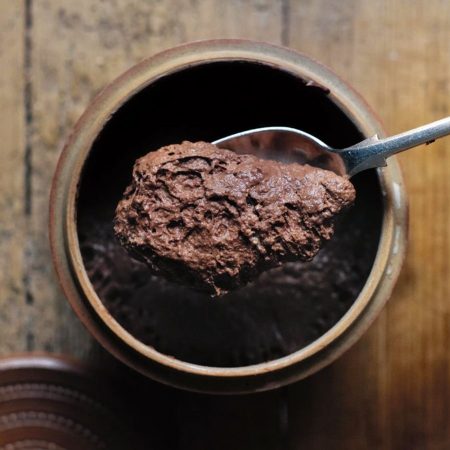Does developing gluten in your starter make for a stronger starter?
In the summer, I was scrolling through instagram and I noticed a new post by @sourdoughgal where she showed how she mixes vigorously while making up her starter. She had seen @breadstalker_ mention, “have you ever thought about building gluten in the starter?”, and wondered whether she was making her starter stronger by developing the gluten by this thorough mixing.
It got me thinking. We do stretch and fold our dough to properly develop gluten and make our dough stronger. Why not the starter? Might this teeny tweak improve the starter and give us even a minimally better outcome to our loaves?
 I don’t think that the development of gluten in a starter is per se what makes a strong starter. I have made gluten free starters, where there is no gluten to develop, that have been perfectly successful, as have a whole host of gluten free bakers out there. However, I do think that this vigorous mixing itself makes the starter more lively. So if bakers mix their starter with the intention of developing gluten and they notice their proofing and final product is marginally improved, maybe this is testament to the fact that they have been under mixing their starter before, rather than it being down to gluten. This is because under mixing your starter is preventing the yeasts from respirating and multiplying efficiently.
I don’t think that the development of gluten in a starter is per se what makes a strong starter. I have made gluten free starters, where there is no gluten to develop, that have been perfectly successful, as have a whole host of gluten free bakers out there. However, I do think that this vigorous mixing itself makes the starter more lively. So if bakers mix their starter with the intention of developing gluten and they notice their proofing and final product is marginally improved, maybe this is testament to the fact that they have been under mixing their starter before, rather than it being down to gluten. This is because under mixing your starter is preventing the yeasts from respirating and multiplying efficiently.
Yeasts are aerobic and anaerobic, and they have the ability to multiply with and without oxygen and enzymes present to respirate and ferment. In Vanessa’s tutorial, she emphasises the importance of mixing vigorously to really aerate the starter, adding oxygen to the starter. This is why when we create a new starter, at the beginning we make sure to give extra stirs throughout the day which helps encourage the yeasts to activate. The more oxygen, the more yeasts and bacteria can form a unifying colony, preventing the bad pathogens from taking hold.
Try mixing your starter for longer than you have been and you might notice that it rises faster. This is because you have added a lot more air into the mix for yeasts to respirate and create more co2. This is also why when we refresh our starter we are taught to mix the water through and create a foam before stirring in the flour, so that we disperse the cultures throughout the starter and provide the yeasts with more air. More examples of how we add oxygen to our starters and doughs is ‘knocking back’, after which you will notice the dough comes back and peaks faster, and the kneading we do by hand or mixer, which aerates the dough with oxygen and enables further respiration to occur.
I find when you talk to professional bakers, or watch their social media, they emphasise how important maintaining their starter is to the success of their baking. It is the consistency of the feedings and keeping the starter at room temperature that they often talk about. However, as home bakers, we are not all able to maintain our starters so commitedly, as this would produce a lot of work and a lot discard just for a weekly bake. Nevertheless, if we utilise a small technique like properly aerating our starters by vigorous mixing (rather than for gluten development), and importantly we remember The Sourdough Club’s teaching of refreshing our starter three times back-to-back before making our bread, we know can still make very good sourdough bread at home. Happy mixing!




Leave a Reply